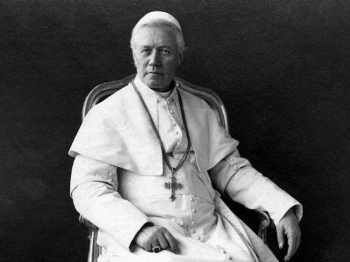Stories of a great history I

Father Michele Bellino, Prior of the Order in Bari and director of the diocesan museum of this East-facing city, has agreed to introduce us to each Grand Master of the Order, through a historical event in the life of the universal Church. This summer he offers us the first article, on Pope St. Pius X, celebrated liturgically on August 21, on one of the four feasts of the Order celebrated by our Knights and Dames. In this article we discover the special attention he showed to the East during the 15th centenary of St. John Chrysostom.
The year 1907 constitutes a historic milestone in the bond between Pope Pius X and the Order, with the letter Quam Multa,1 in which the successor of Peter assumed the title of Grand Master. The decision made the Latin Patriarch of Jerusalem his Lieutenant, so that the members of the Order could better grasp the link between the mother church of Jerusalem and the Roman pontiff himself. The attention towards Eastern Christians was in line with the choices made by Pius IX and Leo XIII. In a speech to the Patriarch of Cilicia of the Armenians, on 18 January 1906, Pius X had expressed himself as follows: “the East, which has the glory of having been the cradle of our Lord Jesus Christ, of preserving his tomb2.”
An event that certainly seemed to manifest Pius X’s pastoral solicitude towards the Churches of the East was the fifteenth centenary of the death of Doctor of the Church Bishop John Chrysostom. On 12 February 1908, a liturgy was celebrated in his presence, officiated by the Greek Melkite Patriarch of Antioch Cyril VIII Geha, with the choir and ministers of the Pontifical Greek College of Rome. In the introduction to the booklet published on that occasion, as the scholar Manuel Nin3 points out, it is indicated that in the aforementioned hall, since there was no “isolated” altar, i.e., detached from the wall, that would allow for movement around it during the various processions and incensations of the Byzantine Divine Liturgy, another “isolated” altar was placed and, in front of it, two lecterns with two icons of Christ and the Mother of God. Next to these was placed a third lectern with the icon of St. John Chrysostom. It is interesting to note that in the introduction to this booklet, this annotation is still indicated: “the Greek rite will be observed in its entirety by the celebrants (...) The Supreme Pontiff, supreme head of all rites, will at the same time also act as presider of the Greek liturgical assembly, to whom the principal acts of honor and jurisdiction are entrusted and reserved (...) He will use the Greek liturgical language”.
The next day, Pius X in a speech addressed to Cardinal Vincenzo Vannutelli, president of the Committee of the fifteenth centenary, said: “Yesterday we attended the solemn Pontifical, which took us back to the time of St. John Chrysostom, in the Basilicas of Antioch and Constantinople, so today we are pleased to see you gathered here to give a new proof of your attachment to the Catholic Church and the Apostolic See. (...) As we think of these things, we feel, like our predecessors, animated by the liveliest desire to work with all our might, so that throughout the East the virtue and greatness of the past may once again flourish, and those false concepts and prejudices that gave rise to the fatal division may be destroyed4.” The event will mark an increasingly welcoming practice and respect for Eastern liturgies, in the path of dialogue between Christians.
1 ACTA APOSTOLICA SEDES (AAS), vol. XL (1907), pp. 321-322.
2 AAS, vol. XXIX (1906), pp. 28-29.
3 cfr. M. NIN, Un vangelo cantato, in L’Osservatore Romano, 20 March 2013.
4 AAS, vol. XLI (1908), pp. 130-134.
(July 2021)



